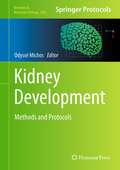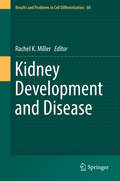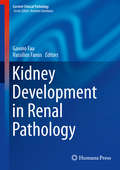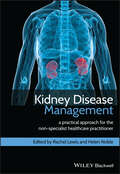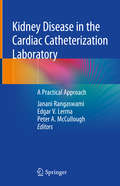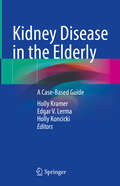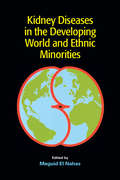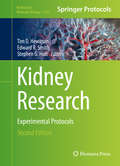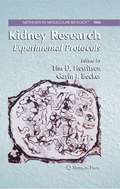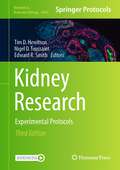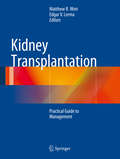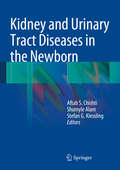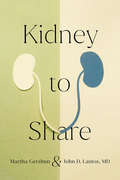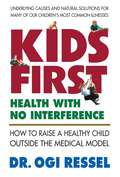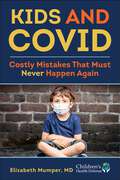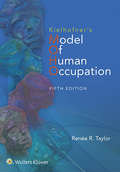- Table View
- List View
Kidney Cancer: Recent Advances in Surgical and Molecular Pathology
by Jae Y. Ro Mukul K. Divatia Ayhan Ozcan Charles C. GuoThis book provides a comprehensive overview of pathology of kidney tumors along with radiological features and up to date treatment strategies that enable the readers to avail this information in day to day pathology sign-out as well as interaction with clinical colleagues of different disciplines. It also serves as a referral resource for the current medical or surgical practice while preparing for examinations or maintenance of certification. Written by experts in the field, chapters contain an updated review of important pathologic parameters mandated for diagnosis and reporting with emphasis on updated information regarding new developments in this interesting field. Numerous high-resolution color images aptly illustrate the various pathologic entities and their features as outlined in the text section along with tables that highlight the differential diagnoses and salient ancillary features. Kidney Cancer serves as a quick reference for all categories of readers alike, and provides up-to-date information on renal tumor pathology, radiology and management that are required in daily practice.
Kidney Development
by Odyssé MichosOver the last decade the development of new molecular biology tools, advanced microscopy, live imaging and systems biology approaches have revolutionized our conception of how embryonic development proceeds. One fundamental aspect of development biology is the concept of morphogenesis: understanding how a group of multipotent cells organize and differentiate into a complex organ. In Kidney Development: Methods and Protocols, expert researchers in the field detail different approaches to tackle kidney development. These approaches include culture and live imaging aspects of kidney development, analyzing the 3-dimensional aspects of branching morphogenesis as well as nephrogenesis, manipulation of the gene/protein expression during kidney development as well as in the adult kidney, and how to assess kidney malformation and disease. Written in the highly successful Methods in Molecular BiologyTM series format, chapters include introductions to their respective topics, lists of the necessary materials and reagents, step-by-step, readily reproducible laboratory protocols, and key tips on troubleshooting and avoiding known pitfalls. Authoritative and practical, Kidney Development: Methods and Protocols seeks to aid scientists in the further study of the process of morphogenesis which is fundamental important not only for studying developmental biology but also for regenerative medicine.
Kidney Development and Disease (Results and Problems in Cell Differentiation #60)
by Rachel K. MillerKidney Development and Disease brings together established and young investigators who are leading authorities in nephrology to describe recent advances in three primary areas of research. The first section describes the use of animal models as powerful tools for the discovery of numerous molecular mechanisms regulating kidney development. The second section focuses on nephric cell renewal and differentiation, which lead to diverse cell fates within the developing kidney, and discusses diseases resulting from the aberrant regulation of the balance between cell fate decisions. The final section concentrates on morphogenesis of the developing kidney and its maintenance after formation as well as the diseases resulting from failures in these processes. Kidney form and function have been extensively studied for centuries, leading to discoveries related to their development and disease. Recent scientific advances in molecular and imaging techniques have broadened our understanding of nephron development and maintenance as well as the diseases related to these processes.
Kidney Development in Renal Pathology
by Gavino Faa Vassilios FanosThis volume provides a comprehensive, state-of-the art review in the field of experimental and human nephrogenesis. The book reviews new data on the effects on kidney development by neonatal asphyxia, obstructive uropathies, nephrotoxic drugs, malnutrition, underfeeding, overfeeding and provides all possible preventive measures to ensure the well-being of the kidney at birth. The book also discusses the possible implications between renal development and the insurgence of kidney disease in adult life and the correlation with renal carcinogenesis. Written by well recognized experts in their fields, Kidney Development in Renal Pathology is a valuable tool for pathologists, neonatologists, nephrologists, gynecologists and researchers with an interest in kidney diseases.
Kidney Disease Management
by Rachel Lewis Helen Noble"This informative book has been put together with the support and input of many clinical renal experts, who have been willing to share their knowledge and years of experience and I'm sure it will be an excellent resource for those caring for kidney patients for the first time - as well as for those with some years of experience!" - From the Foreword by Rosemary Macri, Chief Executive of the British Kidney Patient AssociationKidney Disease Management has been written to help optimise the care of people with chronic kidney disease (CKD) across the healthcare spectrum. It is aimed at a range of professionals, including nurses, junior doctors, general practitioners, pharmacists and dietitians. Specialists in training may also find it useful. It highlights the practical considerations necessary to care for people with kidney problems in situations where a specialist practitioner is not always required or immediately available.This book explores:policy context and CKDoverview of CKD and managementmanaging CKD in primary caretreatment modalities in CKDpsychosocial aspects of living with CKDAcute kidney injury in hospitalised patientssurgery and kidney injurymedication management in CKDnutrition and CKDsupport and palliative care for people with CKDKey features:Based on best practice and written in an accessible format aimed at busy practitionersEmphasises the centrality of the patient and family and the need to share information and expertise across traditional boundariesWritten by professionals renowned in their field, both generalists and specialists, who have extensive experience of the practicalities of managing complex patients
Kidney Disease in the Cardiac Catheterization Laboratory: A Practical Approach
by Edgar V. Lerma Janani Rangaswami Peter A. McCulloughThis book is the first title that focuses exclusively on kidney disease and its impact in the cardiac catheterization laboratory. The increasing prevalence of vascular risk factors such as diabetes, obesity and hypertension coupled with increased longevity has resulted in a worldwide epidemic of cardiovascular and chronic kidney disease (CKD). Never has the impact of one organ system on the other been so profound, as in the current context of cardio-renal interactions. The cross talk between the heart and kidneys is highly relevant in the field of interventional cardiology, given the increasing number of trans-catheter procedures being performed in patients with underlying kidney disease. These procedures also have a significant impact on kidney function and require thoughtful interdisciplinary planning by a cardiorenal team, to achieve optimal outcomes This book assembles the collective expertise of several international leaders in the field of interventional cardiology and nephrology to summarize this complex interface. The book is divided into seven sections to comprehensively cover the topic, including sections on best practices with reduction of contrast associated acute kidney injury, cutting edge techniques to minimize kidney risk with complex interventions, impact of transcatheter valvular procedures on kidney function and the utility of cardio-nephrology teams . Less recognized complications with high morbidity such as athero-embolic renal disease are featured prominently, to increase awareness in the interventional cardiology and nephrology communities. This book is a valuable resource for interventional and structural cardiologists, general cardiologists and nephrologists dealing with the significant overlap areas between these two specialties. It is also relevant to medical students, trainee physicians in nephrology and cardiology, advanced care practitioners and nursing personnel in both specialties . Given the major impact of kidney function on outcomes in patients undergoing cardiac procedures, this textbook serves as a focal point to integrate relevant clinical data from both specialties and help interventional cardiologists achieve optimal outcomes, especially in patients with (or at risk for) kidney disease.
Kidney Disease in the Elderly: A Case-Based Guide
by Edgar V. Lerma Holly Kramer Holly KoncickiThe over-65 population in the United States is rapidly growing. There are currently about 52 million people over 65 years of age in the United States or 16.5% of the U.S. population. This percentage is expected to reach 22% or 70 million by 2050. This means that during the professional lives of current trainees, they can expect to see an increasing number of older patients in their practice. Average life expectancy in 2004 was 75.2 yr for men and 80.4 yr for women. Due to the pandemic, average life expectancy has decreased for both men and women with declines differing by race and ethnicity. Overall, current average life expectancy is 75.1 years for men and 80.5 years for women.During the 1990s, the over-85 population was the fastest growing group at 38% growth. This older age group was the largest consumer of healthcare services. By 2060, the number of people age 85 years and older is projected to triple from its current estimate of 6.7 million to 19.0 million. A substantial percentage of this population has some level of disability: sensory, physical, mental, or self-care. Once a senior develops disability, it greatly impacts their ability to self-manage their disease and follow a complex medical regimen. Patients with chronic kidney disease (CKD) usually require complicated medication routines, complex dietary restrictions, frequent medical visits and receive care from multiple physicians. Thus, providing nephrology care for older patients with CKD requires specific knowledge and skills that are unique to this population. Elderly patients will make up a growing proportion of the practice of nephrologists and other providers (physicians and allied health providers) involved with their care. Clinical practitioners will need to become more comfortable with shouldering the full care of this segment of their patient population and work closely with a geriatrician and internists and family practitioners. As we become more willing to offer life-prolonging technologies in this vulnerable group, we need to be willing to deal with the consequences of this decision. Finally, with their elderly patients, clinicians face challenging ethical problems, such as whether to withhold or withdraw dialysis. Unless addressed promptly and effectively, these ethical issues will greatly increase the stress on both the healthcare provider and family members.
Kidney Diseases in the Developing World and Ethnic Minorities
by Meguid El Nahas Rashad Barsoum John H. Dirks Giuseppe RemuzziCompiled by an international team of nephrologists, this reference covers a wide variety of clinical, regional, and research issues related to the epidemiology, diagnosis, and treatment of kidney disease in ethnic populations-exploring current prevention strategies, treatment outcomes, and education and training practices in Africa, South America,
Kidney Research
by Tim D. Hewitson Edward R. Smith Stephen G. HoltThis second edition expands upon the previous volume with additional emphasis on recent innovation in basic renal research and has a more holistic approach on associated disorders such as complications associated with peritoneal dialysis, ischemic acute kidney injury, the sympathetic nervous system, and vascular calcification. The book is divided into five parts: Part I provides a number of in vitro, in vivo, and ex vivo models of kidney disease and associated complications; Part II looks at recent advances in imaging techniques; Part III covers recent developments in studying metabolism in renal ischemia and reperfusion; Part IV addresses study and measurement of vascular calcification; and Part V explores analytical techniques that are both topical and of widespread relevance to the study of experimental renal disease. Written in the highly successful Methods in Molecular Biology series format, chapters include introductions to their respective topics, lists of the necessary materials and reagents, step-by-step, readily reproducible laboratory protocols, and tips on troubleshooting and avoiding known pitfalls. Authoritative and cutting-edge, Kidney Research: Experimental Protocols, Second Edition is a valuable collection of protocols useful to new and experienced researchers who are interested in the field of Nephrology.
Kidney Research
by Tim D. Hewitson Gavin J. BeckerAs the expense of treating a growing number of end-stage kidney disease patients increases, greater attention has been paid to prevention and early treatment. The study of renal disease, however, suffers due to the complex nature of renal anatomy and physiology and the plethora of different cell types found in the kidney. In Kidney Research: Experimental Protocols, top experts in the field seek to aid researchers by providing a number of specialized techniques developed to examine this intricate system. Through both well-established and novel methods, this volume explores the preparation and culture of the main cell types used to study renal disease mechanisms, the common animal models used to mimic the various forms of human renal disease, and specific applications and techniques used in vivo and in vitro. Written in the highly successful Methods in Molecular BiologyTM series format, the chapters contain step-by-step, readily reproducible laboratory protocols, lists of the necessary materials and reagents, and tips on troubleshooting and avoiding known pitfalls. Essential and cutting-edge, Kidney Research: Experimental Protocols delivers invaluable guidance to new and experienced laboratory researchers delving into the sophisticated study of the kidney.
Kidney Research: Experimental Protocols (Methods in Molecular Biology #2664)
by Tim D. Hewitson Edward R. Smith Nigel D. ToussaintThis third edition provides updated and new chapters on recent innovations in basic renal research. Chapters are divided into three sections covering in vitro, in vivo, and ex vivo models of kidney disease, recent advances in imaging techniques and protocols for performing analytical and functional measurements in the kidney; techniques that are both topical and of widespread relevance to the study of kidney biology and disease. Written in the format of the highly successful Methods in Molecular Biology series, each chapter includes an introduction to the topic, lists necessary materials and methods, includes tips on troubleshooting and known pitfalls, and step-by-step, readily reproducible protocols. Authoritative and cutting-edge, Kidney Research: Experimental Protocols, Third Edition aims to be comprehensive guide for researchers in the field.
Kidney Transplant Management: A Guide To Evaluation And Comorbidities
by Sandesh Parajuli Fahad AzizThis concise book provides an overview of the essential aspects of transplant nephrology. Chapters cover patient evaluation, treatment options, complications and post kidney transplant approaches to various common chronic diseases. The importance of proper immunosuppressants adjustment to improve the graft half-life and overall patient quality of life are also highlighted. Up to date and practical, this book gives nephrologists and providers that treat kidney transplant patients a succinct resource on management.
Kidney Transplantation
by Edgar V. Lerma Matthew R. WeirWith the increased prevalence of kidney transplantation, transplant recipients are being treated in a variety of clinical settings - often beyond the transplant center. There is a greater need for clinicians and allied healthcare professionals to have appropriate guidance on managing these patients. Kidney Transplantation offers the latest evidence-based information on the full range of dilemmas in the medical management of kidney transplant recipients before, during and after transplantation. Beginning with the selection of patients who are candidates for transplantation, this authoritative guide covers the care of the patient on the waiting list and evaluation of donors, preoperative care, induction and immunosuppression maintenance. This wealth of new information and guidelines will serve as an important resource for the best possible care for transplant patients.
Kidney Transplantation in Sensitized Patients
by Duck Jong HanThis book presents state of the art knowledge on all aspects of kidney transplantation in recipients in whom desensitization strategies are necessary in order to overcome immunologic barriers such as anti-human leukocyte antigen (HLA) donor-specific antibody and ABO blood group incompatibility. Readers will find detailed, up-to-date information on the various immunomodulating therapies that may be employed in these circumstances and the outcomes that may be expected. Full guidance is provided on preoperative evaluation and management and post-transplantation care. In addition, the pathology of antibody-mediated rejection and acute cellular rejection in this context is discussed. For most patients with end-stage renal disease, kidney transplantation offers significant benefits compared with dialysis, but especially sensitization to HLAs remains a major clinical obstacle to success. Kidney Transplantation in Sensitized Patients will assist in achieving optimal results in individual patients. It will be an important resource for everyone involved in the care of kidney transplant recipients.
Kidney Transplantation: A Guide to the Care of Kidney Transplant Recipients
by Dianne B. Mckay Steven M. SteinbergKidney Transplantation: A Guide to the Care of Transplant Recipients is an easy to read, up to date, clinical resource written by experts in the field of kidney transplantation. The book explains how donors and recipients are selected for transplantation, how the surgical procedure is performed, and how the experts recognize and treat rejection. Clearly illustrated chapters show how the immune system works in the setting of transplantation and how immunosuppressive medications prevent rejection of the transplanted kidney; knowledge essential for the proper care of the transplant recipient. The acute and long-term care of the patient is described from the perspective not only of proper immunosuppressive medication management, but also from the perspective of comorbidities most common to transplanted patients, including cardiovascular disease, diabetes mellitus, infectious diseases, malignancies, and bone disease. Special issues that impact the care of the transplant recipient, such as unusual donor sources, nonadherence and insurability are also addressed.
Kidney Transplantation: Step-by-Step Surgical Techniques
by Andrzej BaranskiThis book provides a practically applicable guide to the latest techniques in kidney transplantation in an easy-to-digest format. Background is provided on relevant aspects of anatomy and physiology. Detailed step-by-step procedural guidance describes how to successfully perform benching surgery, kidney transplantation and graftectomy techniques. Surgical methods of non-laparoscopic kidney procurement from deceased and living donors are also covered. Potential complications with relevant prevention and resolution strategies are discussed to assist the reader in developing a deep understanding of the methodologies presented. In this book, the author shares his knowledge and experience gained over 35 years in the field of kidney procurement, preparation and transplantation. The book is a monograph and contains many of the author's individual views on certain kidney procurement and transplantation techniques.Kidney Transplantation: Step-by-Step Surgical Techniques is a concise overview of techniques for kidney procurement, benching and transplantation. Therefore, it is a valuable resource for all practicing and trainee practitioners who encounter these patients in their day-to-day practice.
Kidney and Pancreas Transplantation
by Daniel A. Shoskes T. R. SrinivasThe transplant physicians and surgeons at Cleveland Clinic have collaborated to produce, Kidney and Pancreas Transplantation: A Practical Guide. This volume is devoted to kidney and pancreas transplantation and is well grounded in scientific principles, quantitative clinical reasoning, clinical pharmacology, tested clinical practices and overall clinical applicability. Also addressed are key aspects in the initiation, maintenance and sustained growth of viable clinical programs in kidney and pancreas transplantation. Kidney and Pancreas Transplantation: A Practical Guide will be of great value to transplant physicians as well as medical and surgical fellows who intend to pursue an interest in transplantation.
Kidney and Urinary Tract Diseases in the Newborn
by Aftab S. Chishti Shumyle Alam Stefan G. KiesslingThis book provides a comprehensive and up-to-date overview of all key issues related to kidney and urinary tract disease in full-term and premature newborns. Among the many topics addressed are fluid and electrolyte abnormalities, hydronephrosis, urinary tract infection, obstructive uropathy and renal replacement therapy. The approach throughout is clinically oriented, the aim being to provide the reader with hands-on guidance. Each chapter commences with a clinical case vignette and concludes with a take-home message highlighting key aspects of practical importance. In addition, however, informative reviews of the literature and the basic sciences are included. No other book currently on the market focuses solely on the newborn, and Kidney and Urinary Tract Diseases in the Newborn will be especially valuable to those undergoing fellowship training in neonatology or pediatric nephrology/urology.
Kidney to Share (The Culture and Politics of Health Care Work)
by Martha Gershun John D. LantosIn Kidney to Share, Martha Gershun tells the story of her decision to donate a kidney to a stranger. She takes readers through the complex process by which such donors are vetted to ensure that they are physically and psychologically fit to take the risk of a major operation. John D. Lantos, a physician and bioethicist, places Gershun's story in the larger context of the history of kidney transplantation and the ethical controversies that surround living donors. Together, they help readers understand the discoveries that made transplantation relatively safe and effective as well as the legal, ethical, and economic policies that make it feasible. Gershun and Lantos explore the steps involved in recovering and allocating organs. They analyze the differences that arise depending on whether the organ comes from a living donor or one who has died. They observe the expertise—and the shortcomings—of doctors, nurses, and other professionals and describe the burdens that we place on people who are willing to donate. In this raw and vivid book, Gershun and Lantos ask us to consider just how far society should go in using one person's healthy body parts in order to save another person.Kidney to Share provides an account of organ donation that is both personal and analytical. The combination of perspectives leads to a profound and compelling exploration of a largely opaque practice. Gershun and Lantos pull back the curtain to offer readers a more transparent view of the fascinating world of organ donation.
Kids First
by Ogi ResselDesigned for parents, teachers, health professionals, and all who share in the care of children, Kids First helps you determine the underlying causes of many children&’s illness and assists you in creating a healing program that will produce lasting results.Chiropractic healer Dr. Ogi Ressel first looks at the history of conventional medicine, including the current focus on medication. The remainder of the book explains and explores how you can maintain children&’s health without using drugs that actually interfere with an individual&’s innate potential for wholeness. The topics covered include nutrition during pregnancy, infantile colic, fever, ear infections, asthma, and much more. Commonsense remedies are offered, and important topics such as vaccination are discussed in depth. Finally, the author provides the information you need to choose a chiropractor who can restore and safeguard your family&’s well-being. If you have been looking for a more natural, more effective, and far safer way to care for children, Kids First: Health With No Interference will prove to be a valuable reference book as well as a lively bedside read.
Kids and COVID: Costly Mistakes That Must Never Happen Again
by Elizabeth MumperKids and COVID provides an in-depth look at mistakes pandemic officials made that hurt children and adolescents around the world. In spring of 2020, it was understandable that those directing government policies made errors of judgment since data was just emerging. However, within the first year of the declared pandemic, physicians and scientists from around the globe published data and made reliable observations that should have prompted a change of course. Dr. Elizabeth Mumper documents early warnings from eminent clinicians that repurposed drugs could be used to treat patients early, rather than waiting until they had trouble breathing, as advised. Sound epidemiological evidence suggested in March 2020 that the mortality rate of COVID was far less than was reported on mainstream news. Doctors in the trenches treating patients warned of the dangers of hospital protocols, including giving remdesivir with its high rate of kidney damage and omitting appropriate doses of short-term steroids. These scientists and clinicians were gaslighted and accused of spreading &“misinformation.&” The most vulnerable—the young and elderly—suffered massive psychological damage as their social networks were dismantled. Immune function changed as beneficial microbes were disrupted. You may be surprised that what you learn in this book is quite different from what you were told. Kids and COVID calls on parents to organize grassroots efforts on behalf of their children to make global shutdowns and prolonged school closures a &“one and done&” phenomenon.
Kids and Violence: The Invisible School Experience
by Catherine Dulmus Karen SowersImplement prevention interventions and policies to curb the cycle of violence in our schools!Kids and Violence: The Invisible School Experience examines overt and covert violence occurring in the school setting involving students, school personnel, and school policy, and highlights a level of violence that is often hidden, ignored, or subtly tolerated. This book provides the latest research findings on various issues of violence in our schools. It also shows what happens when the adults responsible for the well-being of our children are actually perpetrating violence, staying silent about violence, or upholding a system that supports a violent atmosphere.Kids and Violence is unique in its holistic and systemic approach of examining types of violence that are often overlooked or endorsed by school policies. The book includes 11 chapters focusing on issues such as bullying, school personnel&’s role in violence, and prevention programs. The contributors are experts in their fields and include professors, deans, and directors of university social work schools. Kids and Violence presents the results of an exploratory study that examines self-identified bullies and addresses issues of immediate and vital importance, including: bullying among students, grades 3-8, in a rural school district observations by school personnel on bullying among elementary and middle school students corporal punishment as a cultural norm in the United States and its impact on discipline in our schools solution-focused crisis intervention with adolescents bullying of children and other abuses of power by school personnel adolescent dating violence in the school setting and much more!It is time to stop the harmful cycle of violence in our schools. This valuable resource serves as a call for immediate action, showing social workers and policymakers how to provide leadership in researching, developing, and delivering empirically-based prevention interventions and policies.
Kiefergelenk und Kaustörungen: Ein multidisziplinäres Praxisbuch
by Manuela Motzko Melanie Weinert Ulrike AlbrechtVoraussetzung für eine adäquate Therapie und Behandlung von Störungen im craniomandibulären und orofazialen System ist das ganzheitliche Verständnis über die Funktionsweise des Kiefergelenkes und Kauapparates. Die erfahrenen Autoren zeigen anschaulich und konkret, welche therapeutischen Interventionen bei Patienten mit Störungen im craniomandibulären und orofazialen System möglich sind: • Anatomie und Physiologie der Zähne, des Kiefers und des Kauens• Biomechanische und funktionelle Einschränkungen• Möglichkeiten der Therapie wie Manuelle Therapie, Osteopathie, Tape-Anlage, zahnmedizinische Schienenversorgung und logopädische InterventionenZahlreiche Fotos und Tabellen helfen bei der Befunderhebung und Einschätzung der Störung. Ein praxisnahes Buch für alle Ärzte und Therapeuten, die Patienten mit Dysphagie behandeln: Therapeuten wie Logopäden, Ergotherapeuten und Physiotherapeuten sowie Osteopathen und Zahnärzte, Ärzte unterschiedlicher Fachrichtungen.
Kielhofner's Model of Human Occupation
by Gail Fisher Renee Taylor Patricia BowyerUpdated throughout with the latest research, Kielhofner’s Model of Human Occupation, 6th Edition, is the definitive resource on the theory and application of the most widely used model in occupational therapy today. A client-centered approach explores what motivates each individual, how they select occupations and establish everyday routines, and how environment influences occupational behavior. This revised 6th Edition reflects the current framework and incorporates the most up-to-date MOHO theory, research, and application practices to give users complete preparation for today’s client care challenges.
Kielhofner's Model of Human Occupation: Theory and Application
by Renee TaylorUpdated throughout with new research, this 5th Edition of Kielhofner’s Model of Human Occupation (MOHO) offers a complete presentation of the most widely used model in occupational therapy today. In the new edition, author Renée Taylor preserves Dr. Kielhofner’s original voice and contributions while updating MOHO concepts and their uses in today’s practice environment. Throughout the book, readers will see a client-centered approach used to explore what motivates each individual, how they select occupations and establish everyday routines, and how environment influences occupational behavior. The 5th Edition continues to deliver the latest in MOHO theory, research, and application to practice and adds much that is new, including new case studies that show how MOHO can address the real-life issues depicted and expanded resources that enhance teaching and learning.

